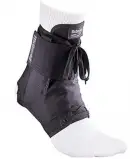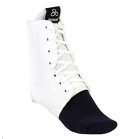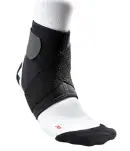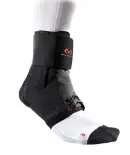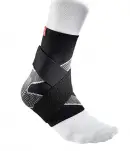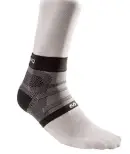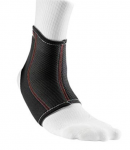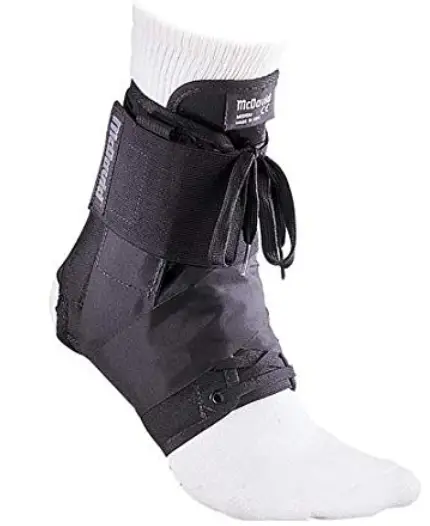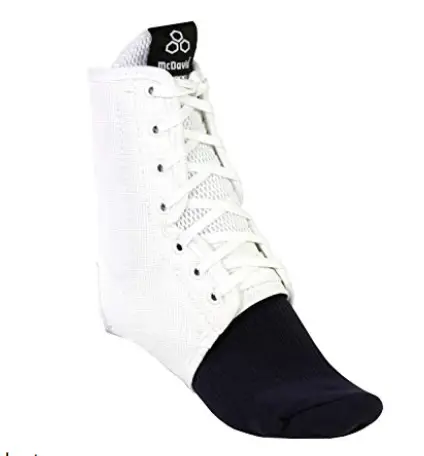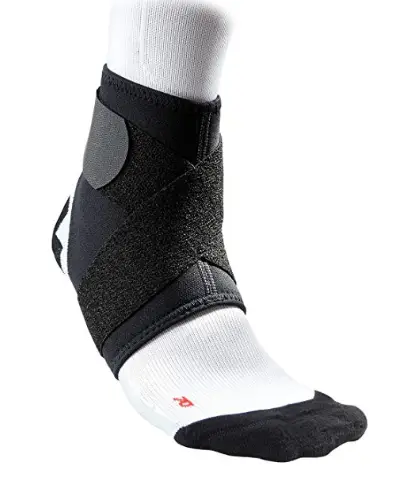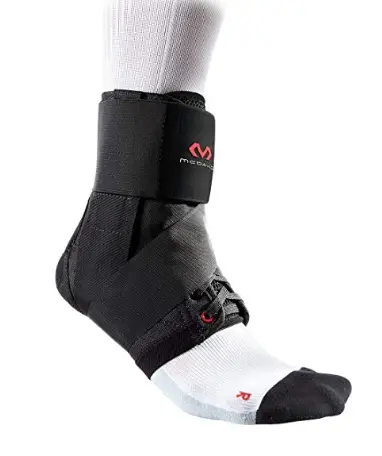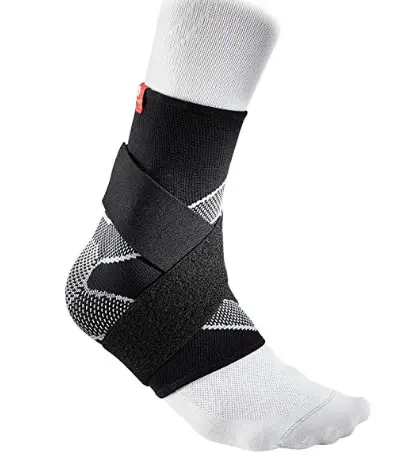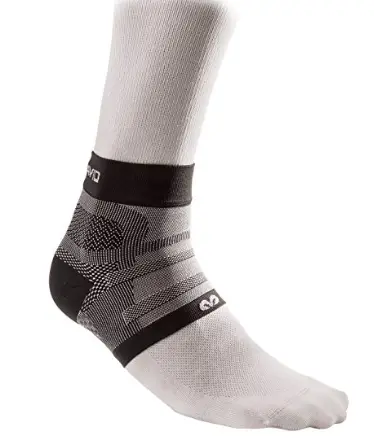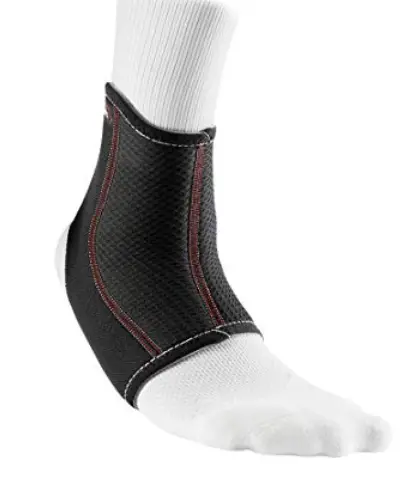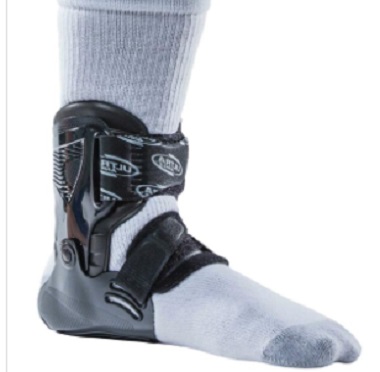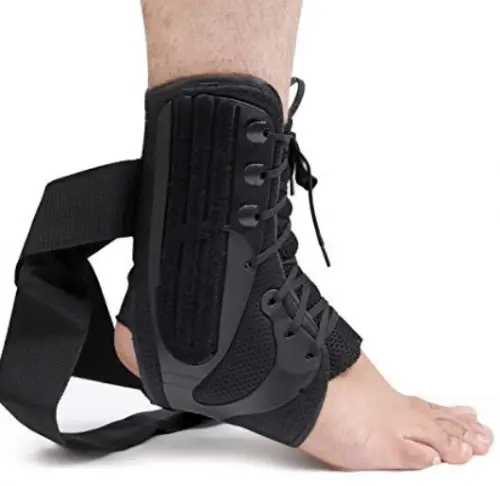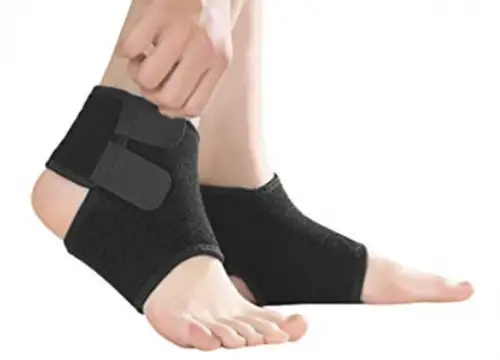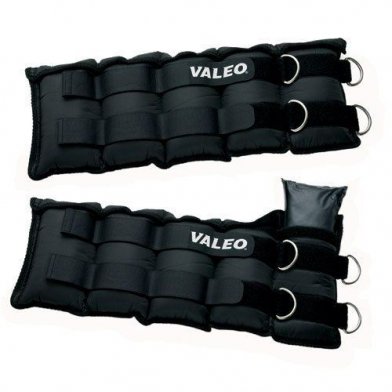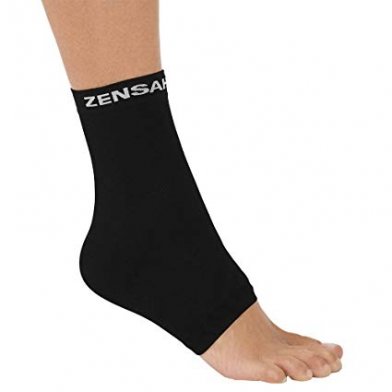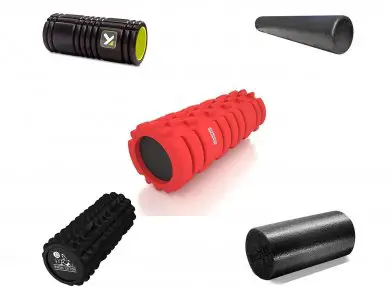McDavid Ankle Brace Review 2024
McDavid Inc. is an American company that creates and sells athletic gear. Their products include sports medicine and injury protection devices McDavid also makes clothing for athletes.
McDavid's founder, Dr. Robert McDavid Jr., designed one of the first injury prevention knee braces for football in 1969.
After fifty years, McDavid products are consistent favorites in professional athletics. Their products receive good reviews, because of their quality, durability, and therapeutic features. Trainers and physical therapists often recommend McDavid products to their clients for injury recovery and prevention.
In today's buying guide, we take a look at some of McDavid's main ankle braces. There are quite a few, so we narrowed down and included a mix of rigid braces and compression wraps.
We rounded out our list with a few alternative products from other manufacturers. We wanted to give you a range of braces to meet your needs.
-
 McDavid 195 Ultralight Ankle Brace
McDavid 195 Ultralight Ankle Brace
-
 McDavid 199 Lace Up
McDavid 199 Lace Up
-
 McDavid Ankle Support with Strap
McDavid Ankle Support with Strap
-
 McDavid 195 Level 3 Max Protection
McDavid 195 Level 3 Max Protection
-
 Way Elastic With Figure 8 Straps
Way Elastic With Figure 8 Straps
-
 McDavid Plantar Fascia With Sleeveless Elastic
McDavid Plantar Fascia With Sleeveless Elastic
-
 McDavid 431 Neoprene Sleeve
McDavid 431 Neoprene Sleeve
-
 Ultra Zoom Ankle Brace
Ultra Zoom Ankle Brace
-
 CompressX Lace Up Ankle Brace
CompressX Lace Up Ankle Brace
-
 Greenery-GRE Kids Ankle Brace
Greenery-GRE Kids Ankle Brace
In a Hurry? The test winner after 20 hours of research
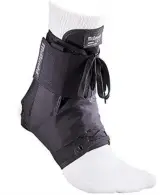
Top strap for customization
Laces help hold tongue in place
Thin polyester fabric lets you breathe
Contains an insert for natural arch support
Best 10 McDavid Ankle Braces
1. McDavid 195 Ultralight Ankle Brace
Top strap for customization
Laces help hold tongue in place
Thin polyester fabric lets you breathe
Contains an insert for natural arch support
Ultralight version is not suitable for some chronic conditions
This lightweight polyester sleeve leaves your toes free to wiggle while providing adjustable compression and circulating air.
Read moreThe polyester is thin enough that it won't interfere with your running or sports sneakers, or any shoe you decide to wear off-court. The top velcro strap lets you control the tightness of compression, dialing back the squeeze as your tendon pain eases. Even the tongue of the sleeve is made with comfort and freedom in mind. It won't press on your front ankle or migrate away from the center, even during fast-paced activity.
There are several models of the 195. It is a mainstay of the McDavid catalog and each model gets consistently good reviews. This one uses a figure 8 strap, in addition to the thick top velcro and traditional laces that hold the tongue in place. The strap is designed to emulate athletic tape, holding commonly damaged muscles in place without rigid restriction.
The 195 comes in different sizes, from extra small to extra large. There is a handy sizing chart on the McDavid website. The Level 3 version, which we linked to, is even good for those with degenerative joint conditions who need extra help staying mobile.
2. McDavid 199 Lace Up
Vinyl, nylon outer is super protective
Ventilated tongue piece
Easy, secure lace closure
Elastic heel and added inner arch insert
May not be comfortable in all shoes
This super stabilizing brace comes in two colors, features laces, and a padded tongue, and has steel stays for ankle immobilization.
Read moreYou won't be able to play basketball in this brace, but that's not really what it is for. It is meant for serious ankle injury recovery. The shell is not thin polyester, but thicker, more rigid nylon and vinyl.
The tougher shell doesn't mean the brace will cause excessive tightness or cut off airflow, though. It holds everything in place, provides compression, and even has vent holes in the tongue. A prominent McDavid logo, along with the stitching pattern, gives the brace a retro look. Any brace will fit both your ankles, so no need to buy a pair if only one of your ankles is in need of care.
Because of the thicker fabric and the metal stays, this brace may have trouble fitting comfortably into some of your shoes. It is a bit of a trade-off, where you get less compatibility but more rigid support to treat your injury and lessen recovery time.
3. McDavid Ankle Support with Strap
Neoprene is tight but flexible and will expand/mold to your foot
Single strap for easy donning/removal
Material is thin and won't weigh you down
Can be machine washed
Feels almost too tight before breaking in
Neoprene not as breathable as polyester/nylon fibers
This McDavid ankle support with a single X strap is made of stretchy, snug, breathable neoprene.
Read moreThe straps secure with Velcro. This makes it simple to slip into the brace, dial in the right fit, and go. The hold and compression feel secure and flexible. This support gives you Level 2 protection, which makes it ideal for minor to moderate sprains and strains as well as light ligament instability or pain. The brace helps prevent ankle rolls, too, so it is a good proactive tool if you don't have an injury.
The one-eighth inch thick neoprene material delivers therapeutic warmth to speed up blood flow and oxygen delivery. The gentle squeezing and partial immobilization will speed up recovery time. Any brace fits both feet, thanks to the bi-directional design. The sleeve is 100% latex-free if you are concerned about allergies or irritation. The support is superb, with a great comfort level to help you forget you are even wearing a brace as you go about your day.
Reviewers, as well as McDavid, did say the brace requires a day or two of breaking in. It will feel abnormally tight at first, but will not pinch or cut off circulation. Neoprene has good molding properties and will feel like a second skin once the initial tightness runs its course.
4. McDavid 195 Level 3 Max Protection
Maximum protection, lightweight package
Nylon and vinyl airy shell
No laces, just straps
Figure 6 strap emulates a bandage wrap
Reviewers notice fit issues-be sure to use the sizing chart
This max security super brace will aid in injury recovery, help manage chronic pain, and guard against ankle injuries if your ankles are healthy and strong.
Read moreThis is the polar counterpart to our number one pick, the 195 Ultralights. Nylon and vinyl construction remains the same. Laces are gone, replaced by the single ankle cuff strap with a figure 6 strap bolstering it. The figure 6 pattern allows you to simulate wrapping your ankle, without the tricky twists and turns of a traditional wrap or bandage.
The shell composite construction makes the brace exceptionally flexible, but it also delivers the guidance and protection you need for injury recovery. The padded lining increases all-over comfort. Sewn-In arch support keeps your feet in their natural and most efficient position. Ergonomic contours are human body-friendly and help make the brace unobtrusive during wear.
The fabric, closures, design, padding, and support combine you Level 3 protection, the maximum level available. This brace would be at home in a locker room as well as a physical therapist's office. Once the brace is on, you will not need to remove your shoe to make on the fly fit adjustments.
5. Way Elastic With Figure 8 Straps
Gel buttresses give gentle support on all four surfaces
Elastic helps with effective heat dissipation
Material will not aggravate most fabric allergies
Figure 8 strap is a classic design in sports medicine
Tightening the strap a bit of a learning curve
This is a good transition product between McDavid's medical/therapeutic flagship products and their more budget-friendly, but still ultra-protective, stretch models.
Read moreYou get moderate, not maximum, pain relief including treatment for chronic or acute cases of tendonitis. Bursitis and arthritis flare-ups, as well as daily wear treatment, are handily covered as well. The elastic is made to stretch in four directions, so no part of your ankle or upper foot gets constricted or left behind. In fact, this is one of a full line of models under the Four-Way moniker, all with that same foot-hugging design.
We mentioned latex allergies earlier. Less common, but just as serious, are neoprene allergies. The spandex and nylon fabric combo gives the shell some of the neoprene's security, and more than enough stretch, without aggravating allergies. This shell construction will also breathe better than neoprene, leading to less foot sweat on hot days.
McDavid placed buttresses on the front, back, and sides of the brace. This is the other tech behind the Four-Way stretch. Being gel, the buttresses will support and hold the brace together, keeping your ankles in place without the rigidity of a steel stay.
6. McDavid Plantar Fascia With Sleeveless Elastic
No annoying seams thanks to the stitching technology
The smaller, shorter design leaves more of your leg free
Can be machine washed
No straps, laces, or tongue
Not suitable for heavy sprain recovery, no protection against ankle rolling
As we get ready to a shift over to non-McDavid products, here is one of the simplest and least expensive foot and ankle compression sleeves that McDavid has to offer.
Read moreThe sleeve is designed specifically for plantar fasciitis, a condition you are probably familiar with if you do any serious running. The tubular stitching and structure of this sleeve will drill down on the tender area without any straps or laces to fuss with. Overall, your whole arch and heel will feel the compression and benefit from better blood flow.
The stitching is done with a thin, narrow needle, suited to microfiber stitching. This results in almost undetectable seams with ergonomic fit and excellent strength. The sleeve is light and easy on your feet, but also durable. It will not lose shape even after repeated wearings and washings.
The sleeve fits either foot. There will not be any chafing, even if the sleeve migrates a bit during the day, because of the precision stitching and barely-there seams. The sleeve got a decent ranking in Amazon's Sports Medicine Products category. Repeated machine washing won't tear down the socks, but they cannot go in the drier and will have to be hung up for air drying.
7. McDavid 431 Neoprene Sleeve
Simple one-piece design is easy to put on
Offers relief for chronic arthritis, tendonitis
Precision stitching means nearly invisible seams
Nylon covering over neoprene adds durability
Neoprene gets hot during hot weather
It doesn't get much simpler or economical than this single piece of neoprene that snugs around your foot and ankle for compression and just the right amount of heat retention for gentle swelling relief.
Read moreLike the Freelastic (our number six), this one uses four-way stretch and noninvasive stitching to cut down on both rigidity and possible chafing. The hardy neoprene is only 1/8" thick, so your skin can breathe and your freedom of movement is preserved. There is nylon on both the inside and outside, making the sleeve durable. There is no additional padding, but this isn't a healing or stabilizing brace, so the neoprene is more than enough.
The double-sided nylon has the side benefit of making this sleeve easy to put on and take off. Since the neoprene isn't especially porous, you get thermal therapy from the slight heat retention. It is a good thing, but also means this won't be a great sleeve for hot summer activities.
The sleeve is also suited to light maintenance of inflammatory conditions, like arthritis or tendinitis. Unfortunately, those of us with these conditions are often targeted for bogus "cures" or special diets that aren't medically proven. McDavid is a solid company, with braces used by many physical therapists, so we are confident in saying that this sleeve will actually help.
The customer reviews answered questions, and the sizing chart is your friend for this product. If your ankle is prone to swelling, you may have to go a size up from your typical shoe size. You will be able to wear a thin toeless sock, under the brace, if you find the fit is a bit too loose.
8. Ultra Zoom Ankle Brace
Flat footbed, but heel cup is open
Solid, rigid plastic stays on sides
Good for any ankle intense sport, or lifting
Open front design prevents overheating
Brace is on the pricey side, but offers great injury prevention
Our last three reviews are brand alternatives to McDavid. We wanted to give you some extra choices, as McDavid braces can get pricey and, at times, the model you want may be sold out at more than one retailer.
Read moreThis brace, from Ultra Ankle, manages to be minimalist and almost Robocop level serious at the same time. It has a flat footbed, quite different from the stitched ones we saw on most of the McDavid products. It is a rigid multisport sleeve, suitable for volleyball, soccer, basketball, and even American football hobbyists.
Although the level of support is moderate, the open design allows for a full range of motion and will fit comfortably inside most sneakers or cleats.
The brace is for injury prevention but looks to be stable enough for mild injury recovery. It has vertical lateral stays, an open back, and two closure straps--one on the ankle and another at midfoot. Both are straightforward velcro closures, with no special figure 6 or figure 8 bolstering.
Just from looking at the picture, the bottom strap is visibly narrower than the bed of fixed velcro is attaches to. It is hardly a deal-breaker, but we know from experience that uncovered velcro can attract debris and dirt. This includes the tiny nits that live inside even the most high-end athletic shoe. It's an aesthetic gripe, but, excess particle buildup can prevent a complete mesh between the strap and the fixed piece if it goes unchecked.
9. CompressX Lace Up Ankle Brace
Uses a unique foot crossing strap design
Comes with directions and tips
Tight laces with derby design/six plastic eyelets
Solid lateral stabilizers
A flexible lace and strap combo sleeve, the CompressX is a helpful hybrid between lightweight flexibility and gentle healing compression.
Read moreThis is not a compression sleeve, instead, it's a sleeve/brace with compression provided by a one-piece strap. The strap is unusual. It hangs from the back of the brace, looking like a pair of suspenders viewed from behind the person wearing them. It is suitable for swelling and sprain recovery. It also guards against initial injuries, without being so thick or heavy that you can't wear it inside shoes or over an actual compression sleeve.
The brace has lateral stabilizers. When you look at the laces, you can see the brace has a modified derby shoe design. The bottom lace holes are part of winglike plastic tabs, one on each side. This design is standard on unisex dress shoes, and sneaker companies like Adidas use it, too, for security and persistent tight laces.
The braces come in two sizes, medium and large, but will fit a large range of ankles due to the design and flexibility. Straps are tightened via touch-fastening, not Velcro, and are very secure after you wrap the straps under and around your feet. As a bonus feature, the CompressX sleeve comes with an e-book that shows you how to use the straps and offers helpful tips for joint pain relief.
10. Greenery-GRE Kids Ankle Brace
Recognized by FDA as a medical device
Good for acute pain as well as chronic conditions
Compression is less severe than for adult ankles
Simple to fasten and unfasten for kids
Will only be helpful for kids up to a certain size; kids will outgrow
This brace, which does come in pairs, is meant for small kids who still wear child size shoes from 12 to 7. As parents know, these sizes are all smaller than the smallest shoe for teens or adults, so these braces would not be appropriate for adults.
Read moreThe child-friendly status reflects in the design and compression level of the sleeve, too. It has two half straps that lay on a large bed of velcro when fastened. It's the simplest of designs, with the thick ankle cuff and lower part acting as compression surfaces. Unlike most adult braces, this one ends just above the heel, like a quarter or ankle sock rather than a crew sock.
The super stretchy brace is made of lycra and nylon, two plasticine fibers with strong elastic properties. It will hold tight to the child's feet, without constricting or weighing down. This is the kind of sleeve that will get your child through their dance recital or soccer game unless their injury is severe enough for them to sit the event out.
The brace aids with tendon and ligament injuries, hyperextensions, sore joints, sprains and strains, and even early-onset arthritis. The twin straps proactively guard against a rolled ankle. The sleeves are made of neoprene with nylon stitching and trim. Although friendly to family budgets, the Greenery-GRE ankle brace is a class 1 medical device, which simply means the FDA recognizes it as a tool meant to heal or prevent injury in the target area.
Criteria Used for Evaluation

Breathability
It's hard enough for an athlete to be sidelined or have to cut back on their favorite sport or activity.
It shouldn't be even worse just because a brace is uncomfortable, heavy, and not porous or thin enough to dissipate heat. With advances in fabric, plastic, and fiber technology, it is possible for a manufacturer to create something that will both immobilize your injured area and let the are stay cool and dry. It isn't just possible--it's really the minimum, in our view. Even a thin, inexpensive, off-brand compression sleeve can now be breathable and allow air to circulate. The ones we reviewed were the ones we felt have the most outstanding and least stifling air circulating properties. The neoprene ones may be thicker than the nylons, but even neoprene can allow for dryness and thermoregulation.

Comfort
An ankle brace isn't exactly evening wear, for most of us.
In other words, a brace is something you wear because you have to, not because it looks stylish. And unlike a button-down shirt or pair of wedge heels, you usually don't wear a brace for a few hours and change out of it as soon as you get home. Depending on how severe or chronic your ankle problem is, you may be wearing a brace for weeks or months at a time.
So, if you have to wear a brace, we feel strongly that the brace should go out of its way to make you as comfortable as possible. This means flexibility, minimal weight, and as much range of motion as possible. It also means the brace should fit comfortably into your shoe, and not become unbearably hot if you put socks under it. As you shop for a brace--if you aren't just assigned one by a doctor--be sure to look for comfort features, ask questions, and form a consensus by reading customer and commercial reviews about the braces you like.

Effectiveness
Considering that not every brace even claims to do the same thing, this can be a little tricky.
Is a brace still effective if it has no straps and can be temporarily pulled into almost any shape? Will a brace that holds your ankle still also allow you to walk like normal? Is it even required to? This is what we mean by saying this factor can be tricky.
To get around the confusion, we simply evaluated and graded each brace on what the manufacturer presented it as doing. The lightweight wraps, from McDavid and others, are just as effective as the Level III lockdown devices. You would not expect a blender bottle to puree a head of cabbage; that isn't what it's for. In the same vein, a rigid brace can't be expected to let you run a marathon without serious consequences.

Fit
Comfort and fit go together, but they are not the same.
An oversized shirt or hat can still be comfortable. A giant umbrella may not be your first choice, because it is cumbersome to carry, but it can still be your best friend in a sudden rainstorm. Ankle braces follow a similar pattern. A rigid brace should fit perfectly, meaning your ankle will barely move while it has an opportunity to heal. But that does not mean it will be comfortable.
A final word about fit: remember to use the sizing charts, any time you order a brace or wrap online. Quite often, your brace size will not be the same as your shoe size. You might be able to get by with a too big wrap, by putting a sock under it; however, you shouldn't have to. And for a too-small brace, there is really nothing you can do but get a refund or exchange. Tight braces, like tight shoes, are too painful to wear and will actually make any injury worse.

Protection
Even the lowest priced brace on the market, if it wants to call itself a brace, will give you some protection.
A paper-thin dress sock will both protect your ankles and feet and protect the lining of the shoe from the natural oils in your skin. We were pretty adamant that we wouldn't review a product if it were unclear how much protection it could provide. This includes protection against potential injury, as well as protecting your ankle when it is already injured. Many of our favorite braces are able to do both these functions without restricting your movement or causing you to overheat.
Expert Interviews & Opinions
You may have noticed that tendonitis and arthritis come up a good bit in any comparison of ankle braces. They both end in "itis," so they must be similar. In fact, the suffix "itis" is from the Greek root word meaning "inflammation." Both arthritis and tendonitis are inflammation disorders. Many braces, especially the more rigid ones, can relieve inflammation.
For physically active people, tendinitis often strikes as a result of overuse, or just a natural part of aging. Inflamed tendons are the cause of tendinitis. One of the most common forms of tendinitis is called tennis elbow. Tennis players constantly use their elbows as they make shots and return serve. The tendons in that area can become tender and irritated after a while.
Tendinitis usually abates in response to resting the affected area. Patients may also need medication or physical therapy. In severe cases, if the tendinitis is not addressed in time, the tendon can rupture. This usually requires surgery to correct it.
Arthritis is more severe, chronic, and potentially debilitating than tendinitis. It can come as a result of osteoarthritis when cartilage wears down. Cartilage is what cushions bones from touching each other; with no cartilage, bones will rub against other bones. Sometimes the breakdown of cartilage is from an injury or serious infection. There is also a form of arthritis, called rheumatoid arthritis, where the patient's own immune system causes the lining in their joints to inflame.
Both tendonitis and arthritis will respond to compression treatment. Immobilizing the joints may also help, and some braces are strong enough to immobilize or seriously restrict bones from moving. These heavy-duty braces or compression sleeves are only available through medical supply houses, often at a doctor's request. If you are experiencing any level of inflammation, it will cause you some pain and perhaps limit your mobility. If the inflammation is in your ankle, the braces and wraps included in this buying guide can all offer you some relief.
You probably don't get excited about sport-related research studies, but we certainly do.
We cannot count the number of times we have read about a product that is "proven in a scientific study" to do what the manufacturer says it will. Often, these claims are a little misleading. The study may have discovered something unfavorable about the product, something that puts the positive results in a different context. Or there may be no study at all, at least not one we could find. We are suspicious of claims that a product got high marks during a study. But a single citation, pointing us towards the study results, can change our minds. We appreciate the chance to read those study results for ourselves.
McDavid set itself apart by sharing the study results right on its website. We have linked to that page in our sources. McDavid gave the Center For Human Performance several of its products for laboratory testing. McDavid let the University of Wisconsin-Madison test their braces as well, on hundreds of high school basketball players. The results were favorable. McDavid braces have a measurable impact on injury prevention. Both studies can be verified, and McDavid was careful not to make any extravagant claims or draw conclusions that the studies did not actually support. For us, this means McDavid is a company we trust and can feel confident in reviewing and recommending to you.
Other Factors to Consider

Stability
Stability is such a basic requirement for a brace that it is not worth even considering a brace that does not offer stability. A stabilizing brace can actually keep you walking in a way that won't cause further injury. It can also keep your injured area so still that it will have a chance to recover, without you having to compromise any mobility. Finally, stability means the brace will encourage your ankle not to roll, thereby avoiding most injuries. This proactive quality is also a factor in a brace's stability.

Upper
By "upper," we really mean the whole brace. The part at the top is made of the same stuff as the toe area or very bottom of the brace. Even a brace with a hard plastic bottom will usually have an outer lining made of nylon, neoprene, spandex, lycra, or a similar breathable, protective fabric. We rated upper materials by how comfortable they will keep you, their compressive abilities, their air circulating properties, and how well they can stretch to accommodate your swollen ankles while still retaining their original shape.
Frequently Asked Questions
q: What do the numbers mean, for level of protection?
There are three levels of protection provided by braces. The levels are indicated by Roman numerals: Level I, Level II, and Level III.
Level I (primary) means the brace will protect you from injury under most conditions. It will relieve pain from strains and sprains past the acute stage. It will also give some relief for inflamed joints. Compression sleeves, as well as most one-piece wraps, are Level I braces.
Level II braces, also called Advanced braces, will provide more moderate protection including ankle immobilization. They will alleviate chronic pain and can be used effectively in an emergency situation.
Level III (Maximum) braces provide the tightest compression and greatest restrictions of movement. Level III braces are reserved for serious ongoing medical conditions, like edemas.
q: What is a Class I medical device?
Class I, II, and III medical devices are ranked, not by the level of protection, but by patient risk. A Class I device has little to no chance of injuring the patient. So when Greenery-GRE calls their kids' brace a Class I, they are saying there is a negligible risk of it injuring a child during wear. Class III medical devices present the highest risk to the user, of injury or illness. Examples include pacemakers and breast implants.
q: So is a Level 3 brace the same as a Class III medical device?
No, they are not the same at all. For one thing, medical device classes come from the FDA. Levels of protection, for braces, are set by the industry and not by a governmental or medical body. Some manufacturers, knowing the average customer does not know about protection levels and risk classes will make false or misleading claims about the medical use of their products.
q: Is there any way to prevent arthritis?
You cannot completely stop arthritis, particularly if it is hereditary. We know that joint and bone injuries increase the risk of later developing arthritis in the affected area. Staying physically active, too, can delay or lessen the severity of arthritis. The level of activity required for potential arthritis prevention is not even that high or strenuous. A regular half-hour or longer walks will make a big difference later in life.
There are many articles and purported studies showing that eating a lot of fish will prevent or lessen the effects of arthritis. According to Harvard Medical School, this connection is not clearly indicated by science. However, eating fish in healthy amounts will certainly give you plenty of protein and vitamins, which can help you stay active longer.
As of now, there is no demonstrable link between fish oil supplements and arthritis remediation.
q: Isn't it true that braces weaken our ankles by making us dependent on them?
Yes, and this is why doctors and physical therapists work to wean their patients off of braces over time. With no brace, the ankle will be so weak that it may not heal properly, and the patient will be left with long term limited mobility. So while it is true that braces are not designed for constant lifetime wear, we feel that not using them at all will cause more harm if you have a lifestyle that can be improved with a brace.
Sources
- , Research, McDavid Official Website
- , What’s the Difference Between the FDA Medical Device Classes?, Medical Supplies Website
- , Arthritis, Mayo Clinic Website
- , Tendinitis, Mayo Clinic Website


